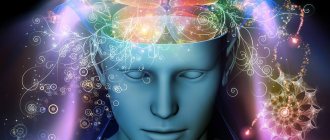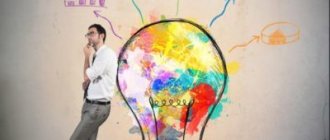Each person perceives the world around him in his own way.
According to the method of perception, one can distinguish the psychotypes of visual, auditory and kinesthetic. Each person is unique, and his individuality is manifested in his appearance, in his manner of speaking, in his style of thinking.
People also perceive the world differently. Some people prefer to look at objects around them, others trust their ears, and others need to feel everything and listen to the sensations.
According to the leading method of perception, the following types of people are distinguished: visual, auditory, kinesthetic.
Kinesthetics - what is it in psychology?
Kinesthetics is one of the channels for a person to perceive information coming from the outside.
This area is responsible for awareness of one’s own body, facial expressions, and physical contacts with other people.
Stroking, hugging, kissing, touching - all this is the area of kinesthetics.
More often, such a perception of reality is characteristic of women who have an increased need for tactile sensations.
In childhood, physical contacts also play an important role, as they help the child gain self-confidence and build trust in the world around him.
How to learn English visually
Visual learners find it easier to learn new information through visual images.
All the ways to learn English with pictures are perfect for you. Do not neglect manuals and various educational materials, they will help to consolidate in your memory the information you heard from the teacher. Tips for visual learners:
- You need to not only hear the information, but also see it. Therefore, we advise you to write down everything you want to memorize and remember for a long time. You can not only write a new word, but also draw a small association picture for it.
- Tip for beginners: A good visual memory allows you to use the following effective method for learning new vocabulary: label the objects in the house. By constantly looking at words, you will significantly expand your vocabulary in just a week.
- Learn English in pictures, read our recommendations in the article "".
- For learning a large number of new words, so-called Picture Dictionaries are ideal.
- Start a diary or blog on the Internet, try to write daily entries in English.
- If you are teaching, use a webcam, it is important for you to have eye contact with the teacher.
- Visual learners sometimes have problems with listening to foreign speech. We have all heard about the language barrier and know almost nothing about the “hearing barrier,” but it occurs quite often. But you can get rid of this problem if you constantly practice listening and train your ears to listen to English speech.
- Watch movies, TV series, news, videos with subtitles. Gradually, your ears will get used to the sound of English speech, and you will be able to watch videos without text.
- After you begin to perceive speech by ear, start studying English audio lessons. Use special materials for beginners: on such recordings, native speakers speak slowly and clearly.
Sensations and feelings
A person of a kinesthetic type primarily experiences the world through sensations and feelings. Visual and auditory effects fade into the background for him .
In theoretical psychology, only proprioception . This is a set of signals coming from receptors in the skin, muscles, tendons, and joints.
They convey the basic sensations that arise during movement, contact with other objects, during changes in body position, etc.
Practical science considers this issue more broadly.
Kinesthetics includes the entire range of sensory experiences: touch, taste perception (sweet, salty, etc.), smells, thermoregulation, pain.
With the help of kinesthetic sensations, a person can analyze the position of his body or the movements performed by its individual parts, even with his eyes closed and the absence of sound signals.
During movements, signals are sent to the brain that are responsible for muscle tone and coordination.
Any movement is controlled by the brain. For this reason, loss of proprioceptive stimulation leads to motor disorders .
Kinesthetic cognition is directly related to vision. On the one hand, the individual visually determines distances using the sensations experienced.
On the other hand, in the absence of visual perception of reality, it is much easier to navigate in space if a familiar visual image is formed in the mind.
For example, when a person moves in a dark room, guided by the touch of his hands on surfaces, he unconsciously reproduces in his head a visual image of a familiar room.
Kinesthetic sensitivity plays a big role in skill development . The automated movements that people make are the result of the development of muscle memory.
Thus, in one’s own home, a person often does not use vision to turn on the light in the room. His hand automatically reaches for the switch, located in its usual place.
How to determine the types of information perception? Test to determine the type of perception
There are several ways to determine your type of perception and find out who you are: auditory, visual, kinesthetic, digital. Let's look at a few.
1. Self-observation. Look, what do you use most often during mental activity? How are your thoughts organized? Vivid pictures and images (visual), sensations (kinesthete), sounds and intonations (auditory), inner speech, logical connections, meanings (digital).
2. Below is a small list of words . After reading, try to understand what was the first thing that came to your mind, with what element did the idea begin? And what happened later?
- Soft touch velvet
- Musician playing violin
- Medicine
- Airplane taking off
If the first thing your idea started with is a picture, an image, then most likely you are a visual person. If the image began with sounds, and only then pictures were presented, then you are an auditory learner. If you needed to physically imagine how objects are located or you quickly developed bodily sensations - kinesthetic, and if you needed to say a word to make it appear - digital.
3. Take a short psychological test using the method “Diagnostics of the dominant perceptual modality by S. Efremtsev”
You can download it directly and, by answering the questions, determine your type of perception. Verification test: visual, auditory, kinesthetic, digital
4. Observe yourself and note what type of short-term memory is most developed for you? What do you grasp quickly and easily: pictures, sounds, sensations, logical connections? What is easier for you to remember?
5. People of each type of perception use in their speech certain phrases and expressions that are characteristic specifically of their leading, triggering system. However, I do not recommend relying on this particular test to determine what type you are. It can give an error in a number of cases when a person has trained himself to communicate in a certain way, use this method only as a complement to the above methods.
How can you determine who you are: visual, auditory, kinaesthetic or digital by speech?
Carefully monitor your speech and write down exactly the phrases that you use to indicate your opinion and your actions. Most often, a person of a particular type of perception uses phrases characteristic of this modality.
Visual
Uses words and phrases related to visual actions : I didn't see, I saw, I noticed, I think it was colorful and great, it looks, focus is concentrated, contrast, perspective, you see.
Audial
They often use phrases with auditory phrases : I can’t understand what you’re saying; didn't hear; I heard it; I recently heard; glad to hear from you; I heard it; the idea sounds tempting.
Kinesthetic
This type of perception is characterized by phrases that show their emotional and bodily responses: I can’t stand it; it's disgusting; it is so sweet; goosebumps; so pleasantly warm; it was a powerful experience. Often their nonverbal signs are very indicative; facial expressions and gestures are telling and reflect the state and emotions of a person, even if there are not many nonverbal signs themselves.
Digital
Digitals pay attention to logic and connections. A specific set of words is not typical for them: phrases of auditory and kinesthetic types may appear. Digital people often ask: what is the point of this; I don’t understand how this is connected; I would like to bring everything into a system; we need to streamline this somehow. However, such expressions are typical of most types with a good sense of organization. Therefore, identifying digital from speech must be done with great care.
Each type has its own characteristics that affect its perception of surrounding information, any educational processes, and interaction with other people. Let us analyze the characteristics of people of different types of perception.
Who is a kinesthetic learner?
Kinesthetics are individuals who perceive reality through sensations. For them, touch becomes the main source of information.
During physical contact with other people or objects, the formation of a basic idea about them occurs. If for a visual learner to better assimilate information it is necessary to evaluate it with their eyes, and an auditory learner needs to listen, then it is important for kinesthetics to touch it.
It is a mistake to say that each person has only one channel of perception. As a rule, pure types are practically never found in nature. Kinesthetics may predominate in an individual, but this does not mean a complete absence of visual or auditory perception of reality.
In the early stages of life, kinesthetic sensations predominate in all people.
Kids constantly strive to touch, feel, stroke, and taste everything.
This is how they learn about the world around them. As they grow older, many people switch to other channels of perception. But there are also those for whom sensory knowledge remains in first place.
to recognize a kinesthetic person by his manner of expressing his own thoughts: “I feel that everything will be fine”, “I was very pleased at this moment”, “I have a feeling that I forgot something”, etc.
From these phrases it immediately becomes clear that the individual interprets even intangible phenomena from the point of view of physical sensations.
A kinesthetic person always strives to touch an object or person . During a conversation, he may periodically squeeze the interlocutor’s hand, pat him on the shoulder, touch his hair, etc. If he sees an interesting object, he will definitely come up to touch and stroke it.
In everyday communication, kinesthetics can be recognized by other signs:
- Always fiddling with something in his hands , moving objects from place to place.
- Tries to avoid eye contact, but at the same time strives to close the distance. A person has no desire to constantly look into the eyes of his interlocutor, since this makes him feel uncomfortable. Interest and sympathy are expressed precisely in the desire to get closer and make physical contact.
- During a conversation, he always touches his opponent . Often people perceive this behavior of a kinesthetic person as a manifestation of sympathy or even physical attraction, but in fact he is immersed in the conversation in this way and fully participates in it.
- At certain moments of communication, he may lose the thread of the conversation and “withdraw into himself . This is due to an uncontrolled switching to one’s own sensations and experiences. At such moments, the individual actually completely falls out of the conversation and becomes immersed in his own thoughts. Often such behavior is demonstrated by kinesthetic children, who during a lesson can daydream and completely disconnect from what is happening.
- He strives to begin solving a problem as quickly as possible and does not tolerate others discussing possible options for the development of events for a long time and carefully.
It’s easier for a kinesthetic learner to start acting right away and make several erroneous attempts to find the right path than to waste time on empty (from his point of view) reasoning. - He has good control over his own body and knows how to control it . For this reason, dancers, ballerinas, and athletes are usually people with a predominant sensory channel of perception.
- Loves and appreciates comfort . Comfort does not mean order and systematicity, but rather a feeling of comfort and tranquility. His house may be a complete mess, but it is in this chaos that he will feel most at home. For the same reason, people of this type can wear the same things for years, which have long lost their visual appeal, but are pleasant to the body and comfortable.
- Relies mainly on his intuition . You can often hear a phrase beginning with the words: “I have a feeling that...”. For this reason, many actions and decisions are the result of internal feelings.
Visual psychotype
More than half of the people on Earth perceive reality primarily with their eyes. This is natural, since vision is a sensory organ through which about 80% of information is perceived.
Thanks to it, you can get an idea of the shape, color, size of various objects, or assess the emotions and state of living beings.
Visual learners have a well-developed visual-associative function of the brain, that is, visual images are first remembered.
Having a rich imagination, a visual person at the same time knows how to plan activities and develop a strategy, as he is able to take in the broad picture with his gaze. He easily concentrates on work without being distracted by noise.
Form and external details are important for representatives of this psychotype. When talking with another person, they establish some distance in order to better examine and analyze the interlocutor.
Visual people have a good sense of style and care about how they look. They love everything beautiful, unattractive things and disorder irritate people of this type.
Visual learners often use the words “look”, “look”, “see”. They are distinguished by a well-trained voice and competent speech.
Channel of perception
Since people with a kinesthetic channel of perception experience the world through feelings and tactile contacts, it is important for others to properly communicate with them.
To win over such an individual and attract his attention to the conversation, you need to put your hand on the shoulder, touch the wrist, hug, etc.
Often such people in a conversation make the same movements with a certain frequency: they rub their eyes, twirl some trinket between their fingers, tap a pen on the table, etc.
Positive emotions in kinesthetics are caused by any pleasant experiences : warmth, softness, pleasant taste, unobtrusive movements.
The sense of smell also plays an important role. Such individuals always feel more comfortable in a room that smells delicious.
Experts recommend that parents and teachers identify the predominant channel of perception in children at an early stage and transmit information to them accordingly.
A kinesthetic child will understand well an adult who periodically strokes his hand, hugs him, etc. A student only needs an approving tap on the shoulder to experience positive emotions and gain self-confidence.
At the same time, it is important not to forget that adequate knowledge of reality is possible only by using all channels. Therefore, sensory sensations must always be supplemented by visual and auditory perception.
Characteristics of the thinking system
Kinesthetic learners primarily trust their senses. They view any events, objects and people through the prism of emotions that arise as a result of interaction .
If, during communication with a kinesthetic learner, the interlocutor demonstrates openness and goodwill, uses handshakes, touches, and claps, then the likelihood of consolidating a positive impression is quite high .
Since information is perceived by individuals in a tactile manner, all thoughts about the issue under discussion are expressed in a similar way: “I can’t accept this,” “I was touched by this topic,” “I feel what the conversation will be about,” etc.
The greatest attention of a kinesthetic learner is attracted to the topic that captures his attention as much as possible. In this case, the risk of being distracted by your own thoughts and experiences is reduced.
So, when presenting information exclusively out loud (for example, during a lecture), you cannot count on good concentration.
But if the same material is supplemented with colorful illustrations that add emotional coloring to the process, the kinesthetic learner is more likely to focus on the topic.
Auditory psychotype
Representatives of this type in their pure form make up only about 10% of the Earth's population. Information is better perceived by them by ear. They have excellent auditory memory.
Auditory people are sociable, happy to discuss problems, and just communicate. They have pleasant, melodic voices and do not like to speak in raised voices.
They are passionate about music and often become successful performers themselves. In order to concentrate, you need complete silence.
Auditory learners have difficulty remembering faces and are also poor at locating their surroundings. When communicating with an interlocutor, they lean closer and do not always look him in the eyes. This helps you perceive information better.
The speech of such people is filled with words: “listen”, “what a sound.”











